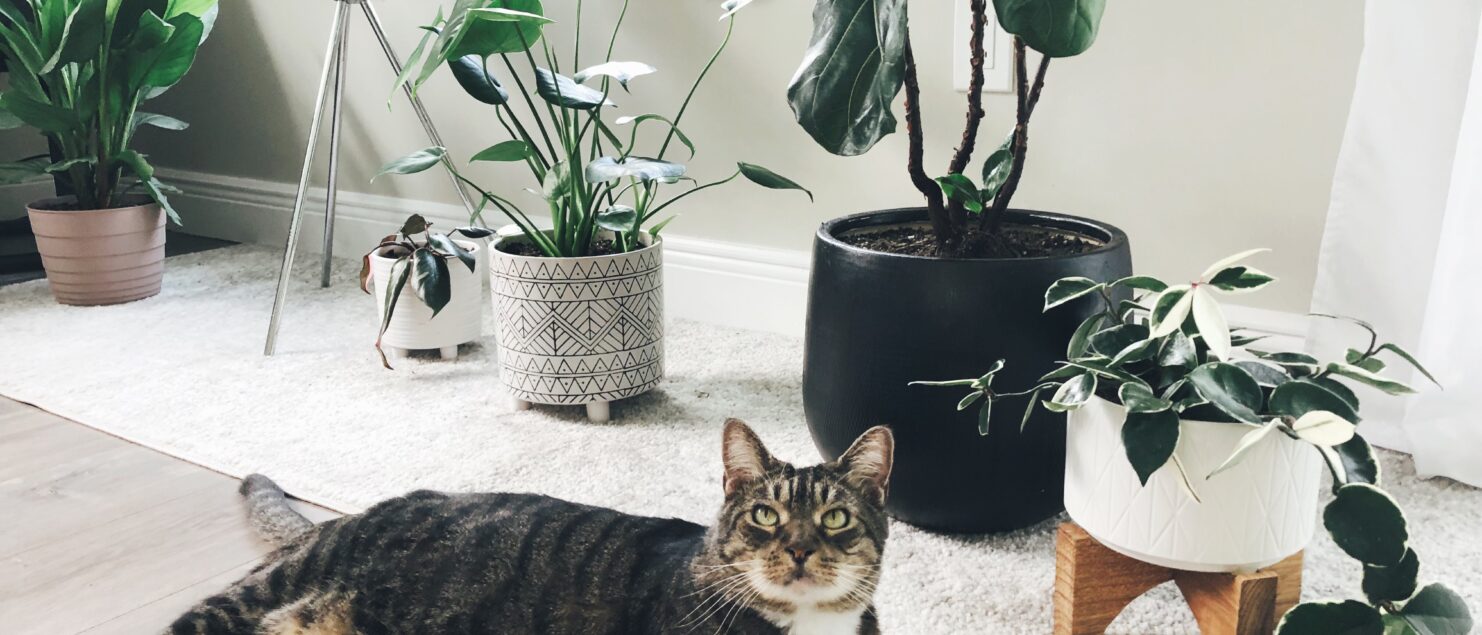10 Popular Plants Toxic To Your Pets
You’re at the store and you come across the PERFECT plant for your home, but could it be toxic? It’s so pretty and everything you want to complete your space. You even have the perfect spot in your home for this new addition. But then you read the label and find out…
It could kill Fluffy or make them really sick.
Don’t fret and take a deep breath. There are ways you can still make it work.
Toxic Plants Are A Common Problem
I’ve found that most of my plants that I have in my collection are actually toxic to pets and even humans. And I have a cat. His name is Roo.
Luckily Roo doesn’t care about my plants. He doesn’t try to chew them and basically just pretends that they don’t exist (much like he does with me).

But despite Roo’s disinterest in my plants, I’ve had cats or dogs that would eat any kind of greenery in the past, even flowers…
Because of them, I didn’t have many plants in my home growing up (at least not real ones).
Before you purchase a new plant, you should always do some research first.
Any big box chain or plant shop will have tags on their plants indicating whether it’s safe for pets among other care guidelines.
If you’re buying plants from a plant shop or nursery, ask employees for their knowledge on any specific plant – those guys are plant nerds like me and know their stuff.
But if you don’t want to rely on others to keep your pets safe, you need to know what plants to be careful with.
Here are 10 extremely popular plants that can be toxic to your pets:
#1 Aloe

What? Aloe? Yes. The same stuff you pour over your bodies for sunburn relief, and the same thing you drink to aid digestion.
It may not be toxic to you or I, but Fido will suffer from it, if he/she ingests it. It can cause vomiting and diarrhea.
Toxicity: Mild
#2 Lilies

Peace lily, Callie lily, Easter lily, Tiger lily… Maybe just avoid lilies all together.
While lilies are beautiful, like the peace lily with its angelic, pure white blooms, they pose a risk to any pet that eats them.
If your pet eats a peace lily (or any other), they won’t be too peaceful at all. Lilies cause a painful burning sensation in the mouth of pets and will make it difficult for your feline or canine friend to swallow.
Toxicity: High
#3 ZZ Plant

The ZZ plant is a very popular houseplant due to its hardiness. People who can’t seem to keep anything else alive tend to have luck with the ZZ.
But when your pet gets a hold of this plant, it can cause irritation in the mouth and excessive drooling.
Toxicity: Mild
#4 English Ivy

English ivy is also a very popular houseplant for the same reasons as the ZZ. They’re very easy to grow and can withstand various conditions.
This plant can cause vomiting, diarrhea, and drooling.
Toxicity: Mild
#5 Cactus

You might think this is a no-brainer due to its sharp spikes, but to a pet, cacti look like a fuzzy toy or a snack.
After one bite they probably will regret their decision and most likely won’t do it again.
Unfortunately, all it takes is one bite to leave them with sharp spikes lodged into their mouths. These spikes can cause irritation, inflammation and infection if not properly treated.
Toxicity: Mild-High (depending on severity and type)
#6 Bird of Paradise

The bird of paradise is becoming a very sought after houseplant. You can’t look at home décor inspiration on Pinterest without coming across one of these in the background.
But as beautiful as they are, I hope these home decorators don’t have pets that get anywhere near them! The bird of paradise is VERY toxic to pets and humans.
The main chemical in this plant is prussic acid – the main ingredient used in gas chambers in World War II.
Eating any part of this plant can lead to vomiting, diarrhea, difficulty breathing, and even death.
Should a pet eat this plant, they can die within minutes.
Toxicity: Extremely High
#7 Arrowhead Plant

You can’t help but fall in love these heart-shaped leafy plants!
They’re so cute! I like to call them land lily pads since they so closely resemble them.
These plants contain toxic sap that, if ingested, can cause vomiting, diarrhea, and decreased appetite in pets.
Toxicity: Mild
#8 Sago Palm

These plants aren’t necessarily considered houseplants (though some keep them indoors), but they’re a very popular plant for landscaping.
I live in Florida and I see these in a lot of yards – they’re all over the place.
This plant is very toxic to pets, more worrisome for dogs, since they’ll eat anything. Cats aren’t in the clear either if you’ve got an outdoor cat or an indoor sago, so be careful!
This plant can cause serious liver damage and liver failure. It can also cause bruising and clotting. This plant will ultimately cause death, if ingested and not treated immediately.
Toxicity: Extremely High
#9 Snake Plant

Ahh, the snake plant: one of my favorites.
Snake plants have long and sharp blades that can cause wounds. They can cut you, much like a paper cut if you brush against the side of one of their leaves too quickly.
These sharp edges can instantly cause gums to bleed in dogs and cats that try to chew on them.
If consumed in large doses, your pet can experience vomiting and diarrhea. In extreme cases, the snake plant can cause your pet’s throat and tongue to swell.
Toxicity: Mild
#10 Philodendron

The philodendron family categorizes many popular plants today.
From the monstera to the famous pink princess plant – there are a lot of philodendrons common among houseplant collectors.
Philodendrons can cause oral discomfort and swelling when ingested, which can make it difficult to swallow. Your pet could start choking if they eat any part of these plants.
Toxicity: Mild
Proceed With Caution
There are many ways you can still keep these plants in your home with a bit of caution. Start by making sure they’re not accessible to any pets or even small children.
I keep the plants in my collection that I know are dangerous up on a bookshelf or a counter. This ensures that my cat or little ones who come to visit can’t reach them.

Even if you have a cat like mine who doesn’t seem to mess with the plants, take precautions. They could change their mind at any time and suddenly the plant that they’ve never gotten near could look like a great new chew toy.
If you suspect your pet has come in contact with a toxic plant, make sure you bring them to the vet immediately. There’s no sense in waiting it out. Even if they didn’t eat much of that toxic plant, it’s just not worth the risk.
Do you have any of these plants in a home with pets or a past experience that’s made you nervous to introduce them? I’d love to hear your experience in a comment below!
Want More Like This?
Join my email list to get the latest tips & tricks for home plant design and care!

